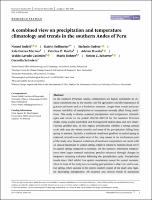Mostrar el registro sencillo del ítem
A combined view on precipitation and temperature climatology and trends in the southern Andes of Peru
| dc.contributor.author | Imfeld, Noemi | |
| dc.contributor.author | Sedlmeier, Katrin | |
| dc.contributor.author | Gubler, Stefanie | |
| dc.contributor.author | Correa, Kris | |
| dc.contributor.author | Davila Arriaga, Cristina | |
| dc.contributor.author | Huerta, Adrian | |
| dc.contributor.author | Lavado-Casimiro, W. | |
| dc.contributor.author | Rohrer, M. | |
| dc.contributor.author | Scherrer, Simon C. | |
| dc.contributor.author | Schwierz, Cornelia | |
| dc.date.accessioned | 2020-07-28T02:02:35Z | |
| dc.date.available | 2020-07-28T02:02:35Z | |
| dc.date.issued | 2020-05-13 | |
| dc.identifier.uri | https://hdl.handle.net/20.500.12542/425 | |
| dc.description.abstract | In the southern Peruvian Andes, communities are highly dependent on climatic conditions due to the mainly rain-fed agriculture and the importance of glaciers and snow melt as a freshwater resource. Longer-term trends and year-to-year variability of precipitation or temperature severely affect living conditions. This study evaluates seasonal precipitation and temperature climatologies and trends in the period 1965/66–2017/18 for the southern Peruvian Andes using quality-controlled and homogenized station data and new observational gridded data. In this region, precipitation exhibits a strong annual cycle with very dry winter months and most of the precipitation falling from spring to autumn. Spatially, a northeast–southwest gradient in austral spring is observed, related to an earlier start of the rainy season in the northeastern part of the study area. Seasonal variations of maximum temperature are weak with an annual maximum in austral spring, which is related to reduced cloud cover in austral spring compared to summer. On the contrary, minimum temperatures show larger seasonal variations, possibly enhanced through changes in longwave incoming radiation following the precipitation cycle. Precipitation trends since 1965 exhibit low spatial consistency except for austral summer, when in most of the study area increasing precipitation is observed, and in austral spring, when stations in the central-western region of the study area register decreasing precipitation. All seasonal and annual trends in maximum temperature are larger than trends in minimum temperature. Maximum temperature exhibits strong trends in austral winter and spring, whereas minimum temperature trends are strongest in austral winter. We hypothesize, that these trends are related to precipitation changes, as decreasing (increasing) precipitation in spring (summer) may enhance maximum (minimum) temperature trends through changes in cloud cover. El Niño Southern Oscillation (ENSO), however, has modifying effects onto precipitation and temperature, and thereby leads to larger trends in maximum temperatures. | en_US |
| dc.format | application/pdf | |
| dc.language.iso | eng | en_US |
| dc.publisher | John Wiley and Sons | en_US |
| dc.relation.ispartof | urn:issn:1097-0088 | |
| dc.rights | info:eu-repo/semantics/openAccess | en_US |
| dc.rights | Atribución-NoComercial-SinDerivadas 3.0 Estados Unidos de América | * |
| dc.rights.uri | http://creativecommons.org/licenses/by-nc-nd/3.0/us/ | * |
| dc.source | Repositorio Institucional - SENAMHI | en_US |
| dc.source | Servicio Nacional de Meteorología e Hidrología del Perú | en_US |
| dc.subject | Agrometeorología | en_US |
| dc.subject | Agroclimatología | en_US |
| dc.subject | Control de Calidad | en_US |
| dc.subject | Climatología | en_US |
| dc.subject | Lluvia | |
| dc.subject | Climatología | |
| dc.subject | Precipitación | |
| dc.subject | Temperatura | |
| dc.subject | Andes | |
| dc.subject | Altiplano | |
| dc.title | A combined view on precipitation and temperature climatology and trends in the southern Andes of Peru | en_US |
| dc.type | info:eu-repo/semantics/article | en_US |
| dc.identifier.isni | 0000 0001 0746 0446 | |
| dc.description.peerreview | Por pares | |
| dc.identifier.doi | https://doi.org/10.1002/joc.6645 | |
| dc.identifier.journal | International Journal of Climatology | |
| dc.source.journal | International Journal of Climatology |
Ficheros en el ítem
Este ítem aparece en la(s) siguiente(s) colección(es)
-
Artículo científico [168]









